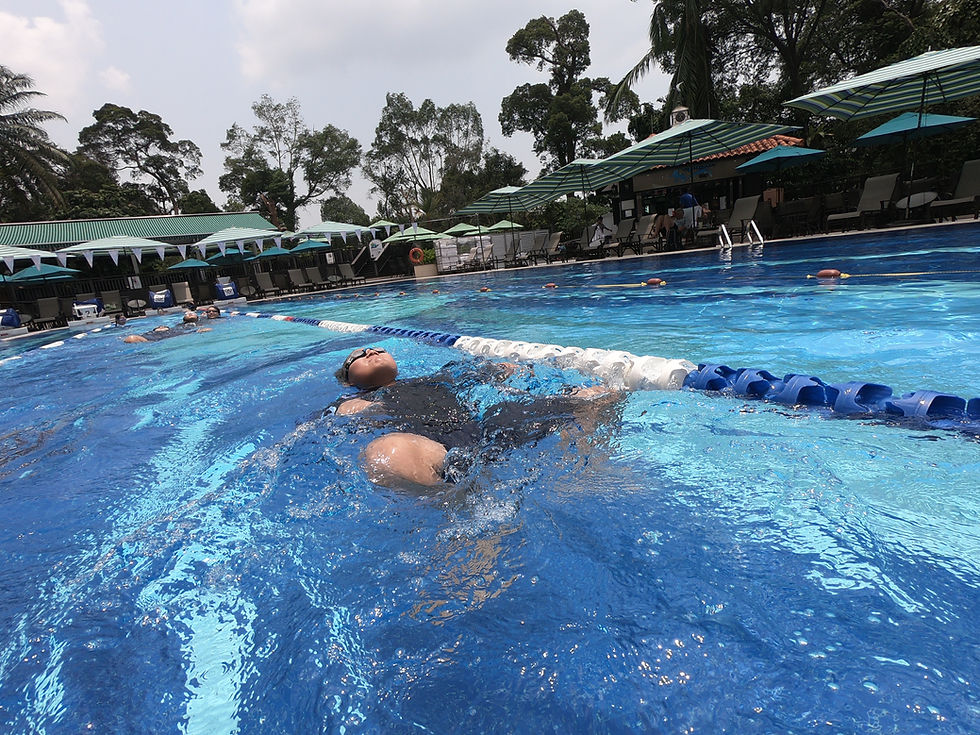Safety Precautions for Swimming in Natural Water Bodies
- SG Sink Or Swim

- Apr 17
- 3 min read

Swimming in natural water bodies — such as lakes, rivers, and oceans — offers a refreshing connection to nature, a sense of freedom, and endless adventure. However, unlike swimming pools, natural waters come with unpredictable elements that can pose serious safety risks if you're not prepared.
Whether you're a recreational swimmer, triathlete, or someone just looking to cool off during a hot day, understanding the safety precautions for swimming in natural water bodies is essential for an enjoyable and hazard-free experience.
🌊 Why Swimming in Natural Waters Is Different
Unlike pools, natural environments aren’t controlled. They vary in temperature, depth, visibility, currents, and even wildlife. Without awareness and preparation, even strong swimmers can find themselves in danger.
Common Natural Water Hazards:
Strong currents or tides
Uneven, muddy, or slippery bottoms
Cold water shock
Debris or underwater obstructions
Sudden drop-offs
Limited visibility
Waterborne illnesses or contamination
✅ Knowing how to prepare for these conditions can keep you safe while enjoying nature.
🧠 Top Safety Precautions for Open Water Swimming
1. Know the Water Conditions
Before you swim, research or ask locals about:
Water depth and clarity
Currents, tides, or sudden changes in flow
Weather forecasts — avoid swimming before or after storms
Recent wildlife sightings or hazardous algae blooms
💡 Avoid swimming in unfamiliar or murky waters without a guide or spotter.
2. Never Swim Alone
Even experienced swimmers should never enter open water alone. Natural water bodies are unpredictable, and having a buddy could save your life.
Swim with a friend, group, or lifeguard nearby
Always let someone know where you’re going and when you’ll be back
Use the “10:20 rule” for children — always within 10 feet, eyes on every 20 seconds
3. Enter the Water Slowly
Jumping or diving into natural water can be dangerous:
You may hit submerged rocks or debris
Water could be colder than expected, triggering cold water shock
Currents may be stronger near the surface than you realize
✅ Walk in gradually to test temperature and footing.
4. Use Proper Equipment
Having the right gear improves safety and visibility.
Bright-colored swim cap or rash guard — makes you visible to boats and lifeguards
Swim buoy or float — offers rest and increases visibility
Wetsuit — helps regulate temperature in cold water
Water shoes — protect feet from sharp rocks, glass, or slippery algae
5. Be Aware of Currents and Rip Tides
If you’re in a river or ocean:
Swim parallel to the shore if caught in a current
Don’t fight the current — stay calm and conserve energy
Look for sheltered areas or swimming zones marked safe by lifeguards
💡 If you're not sure, don’t swim in fast-moving or tide-influenced waters.
6. Stay Within Your Limits
Natural water swimming is more tiring than pool swimming due to:
Waves or resistance
Lower temperatures
No wall to rest on
✅ Swim close to shore and pace yourself, especially if you're not used to open water.
7. Avoid Alcohol or Drugs
Swimming under the influence:
Slows reflexes and decision-making
Affects balance and temperature regulation
Increases risk of drowning
🚫 Save the celebration for after you’ve left the water safely.
8. Watch for Wildlife
Avoid swimming in areas known for jellyfish, leeches, snakes, or aggressive fish.
Never feed wildlife or disturb nesting areas.
Don’t panic if you see marine life — stay calm and swim steadily away.
✅ Respect the environment and its inhabitants.
9. Check for Contamination Warnings
Pollution or bacteria (like E. coli or blue-green algae) can make natural water unsafe.
Check online or at local parks for water quality reports
Avoid swimming in still water after heavy rainfall
Look for signs of unusual water color, foam, or foul odors
10. Be Prepared for Emergencies
Know basic water rescue skills and CPR
Bring a first aid kit
Carry a whistle or signaling device
Have an emergency exit strategy — know where to get out safely
🧭 Before You Swim: A Quick Safety Checklist
✅ Is the water free from posted warnings?
✅ Do you know the weather and current forecast?
✅ Are you swimming with a buddy or group?
✅ Are you visible to others (boats, lifeguards)?
✅ Do you know your exit points and landmarks?
✅ Are you hydrated, sober, and feeling well?
🏁 Final Thoughts
Swimming in natural water bodies can be one of the most rewarding experiences in nature — but it comes with responsibilities. By understanding the risks and preparing accordingly, you can enjoy the freedom, fun, and fitness benefits of natural water swimming while staying safe.
With a healthy respect for nature and smart decision-making, you'll make every lake, river, or ocean swim a safe and memorable adventure.





Comments